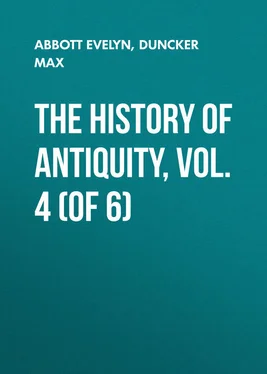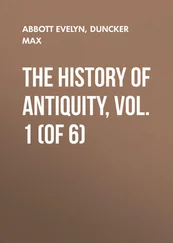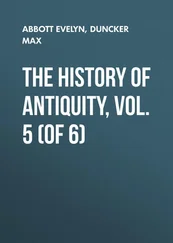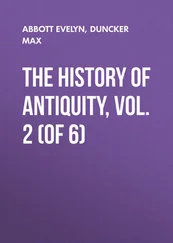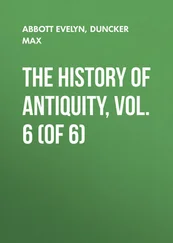Max Duncker - The History of Antiquity, Vol. 4 (of 6)
Здесь есть возможность читать онлайн «Max Duncker - The History of Antiquity, Vol. 4 (of 6)» — ознакомительный отрывок электронной книги совершенно бесплатно, а после прочтения отрывка купить полную версию. В некоторых случаях можно слушать аудио, скачать через торрент в формате fb2 и присутствует краткое содержание. Жанр: foreign_antique, foreign_prose, Историческая проза, на английском языке. Описание произведения, (предисловие) а так же отзывы посетителей доступны на портале библиотеки ЛибКат.
- Название:The History of Antiquity, Vol. 4 (of 6)
- Автор:
- Жанр:
- Год:неизвестен
- ISBN:нет данных
- Рейтинг книги:5 / 5. Голосов: 1
-
Избранное:Добавить в избранное
- Отзывы:
-
Ваша оценка:
- 100
- 1
- 2
- 3
- 4
- 5
The History of Antiquity, Vol. 4 (of 6): краткое содержание, описание и аннотация
Предлагаем к чтению аннотацию, описание, краткое содержание или предисловие (зависит от того, что написал сам автор книги «The History of Antiquity, Vol. 4 (of 6)»). Если вы не нашли необходимую информацию о книге — напишите в комментариях, мы постараемся отыскать её.
The History of Antiquity, Vol. 4 (of 6) — читать онлайн ознакомительный отрывок
Ниже представлен текст книги, разбитый по страницам. Система сохранения места последней прочитанной страницы, позволяет с удобством читать онлайн бесплатно книгу «The History of Antiquity, Vol. 4 (of 6)», без необходимости каждый раз заново искать на чём Вы остановились. Поставьте закладку, и сможете в любой момент перейти на страницу, на которой закончили чтение.
Интервал:
Закладка:
Max Duncker
The History of Antiquity, Vol. 4 (of 6)
BOOK V.
THE ARIANS ON THE INDUS AND
THE GANGES
CHAPTER I.
THE LAND AND THE PEOPLE
It was not only in the lower valley of the Nile, on the banks of the Euphrates and the Tigris, and along the coast and on the heights of Syria that independent forms of intellectual and civic life grew up in antiquity. By the side of the early civilisation of Egypt, and the hardly later civilisation of that unknown people from which Elam, Babylon, and Asshur borrowed such important factors in the development of their own capacities; along with the civilisation of the Semites of the East and West, who here observed the heavens, there busily explored the shores of the sea; here erected massive buildings, and there were so earnestly occupied with the study of their own inward nature, are found forms of culture later in their origin, and represented by a different family of nations. This family, the Indo-European, extends over a far larger area than the Semitic. We find branches of it in the wide districts to the east of the Semitic nations, on the table-land of Iran, in the valleys of the Indus and the Ganges. Other branches we have already encountered on the heights of Armenia, and the table-land of Asia Minor (I. 512, 524). Others again obtained possession of the plains above the Black Sea; others, of the peninsulas of Greece and Italy. Nations of this stock have forced their way to the shores of the Atlantic Ocean; we find them settled on the western coast of the Spanish peninsula, from the mouth of the Garonne to the Channel, in Britain and Ireland no less than in Scandinavia, on the shores of the North Sea and the Baltic. Those branches of the family which took up their abodes the farthest to the East exhibit the most independent and peculiar form of civilisation.
The mutual relationship of the Arian, Greek, Italian, Letto-Sclavonian, Germanic, and Celtic languages proves the relationship of the nations who have spoken and still speak them; it proves that all these nations have a common origin and descent. The words, of which the roots in these languages exhibit complete phonetic agreement, must be considered as a common possession, acquired before the separation; and from this we can discover at what stage of life the nation from which these languages derive their origin stood at the time when it was not yet divided into these six great branches, and separated into the nations which subsequently occupied abodes so extensive and remote from each other. We find common terms for members of the family, for house, yard, garden, and citadel; common words for horses, cattle, dogs, swine, sheep, goats, mice, geese, ducks; common roots for wool, hemp or flax, corn ( i. e. wheat, spelt, or barley), for ploughing, grinding, and weaving, for certain metals (copper or iron), for some weapons and tools, for waggon, boat and rudder, for the elementary numbers, and the division of the year according to the moon. 1 1 Whitney, "Language," p. 327; Benfey, "Geschichte der Sprachwissenchaft," s. 598.
Hence the stock, whose branches and shoots have spread over the whole continent of Europe and Asia from Ceylon to Britain and Scandinavia, cannot, even before the separation, have been without a certain degree of civilisation. On the contrary, this common fund of words proves that even in that early time it tilled the field, and reared cattle; that it could build waggons and boats, and forge weapons, and if the general name for the gods and some names of special deities are the same in widely remote branches of this stock, – in India, Iran, Greece, and Italy, and even on the plains of Lithuania, – it follows that the notions which lie at the base of these names must also be counted among the common possessions existing before the separation.
We can hardly venture a conjecture as to the region in which the fathers of the Indo-European nations attained to this degree of cultivation. It must have been of such a nature as to admit of agriculture beside the breeding of cattle. The varieties of produce mentioned and the domestic animals point to a northern district, which, however, cannot have reached down to the ocean, inasmuch as no common roots are in existence to denote the sea. This proof is strengthened by the fact that in all the branches the wolf and bear alone among beasts of prey are designated by common roots. If we combine these considerations with the equal extension of the tribes of this nation towards east and west, we may assume that an elevated district in the middle of the eastern continent was the abode of the nation while yet undivided.
The branches which occupied the table-land of Iran and the valley of the Indus were the first to rise from the basis acquired in common to a higher civilisation; and even they did not attain to this till long after the time when Egypt, under the ancient kingdom of Memphis, found herself in the possession of a many-sided culture, after Babylon had become the centre of a different conception of life and development. The western branches of the Indo-Europeans remained at various stages behind their eastern fellow-tribesmen in regard to the epochs of their higher culture. If the Greeks, who were brought into frequent contact with the civilisation of the Semites, came next in point of time after the eastern tribes, and the Italians next to the Greeks, it was only through conflict and contact with the culture of Greece and Rome that the western branches reached a higher stage, while the dwellers on the plains of the Baltic owe their cultivation to the influences of Germanic life. Finally, when the West European branches, the Indo-Germans, had developed independently their capacities and their nature, when in different phases they had received and assimilated what had been left behind by their Greek and Roman kinsmen, and formed it into the civilisation of the modern world, their distant navigation came into contact with the ancient civilisation, to which their fellow-tribesmen in the distant East had finally attained some 2000 years previously. With wonder and astonishment the long-separated, long-estranged relatives looked each other in the face. But even now the ancient, deeply-rooted, and variously-developed civilisation of the eastern branch maintains its place with tough endurance beside the mobile, comprehensive, and restlessly-advancing civilisation of the west.
On the southern edge of the great table-land which forms the nucleus of the districts of Asia, the range of the Himalayas rises in parallel lines. The range runs from north-west to south-east, with a breadth of from 200 to 250 miles, and a length of about 1750 miles. It presents the highest elevations on the surface of the earth. Covered with boundless fields of snow and extensive glaciers, the sharp edges and points of the highest ridge rise gleaming into the tropic sky; no sound breaks the deep silence of this solemn Alpine wild. To the south of these mighty white towers, in the second range, is a multitude of summits, separated by rugged ravines. Here also is neither moss nor herb, for this range also rises above the limits of vegetation. Much lower down, a third range, of which the average elevation rises to more than 12,000 feet, displays up to the summits forests of a European kind; in the cool, fresh air the ridges are clothed with birches, pines, and oaks. Beneath this girdle of northern growths, on the heights which gradually sink down from an elevation of 5000 feet, are thick forests of Indian fig-trees of gigantic size. Under the forest there commences in the west a hilly region, in the east a marshy district broken by lakes which the mountain waters leave behind in the depression, and covered with impenetrable thickets, tall jungles, and rank grass – a district oppressive and unhealthy, inhabited by herds of elephants, crocodiles, and large snakes.
Читать дальшеИнтервал:
Закладка:
Похожие книги на «The History of Antiquity, Vol. 4 (of 6)»
Представляем Вашему вниманию похожие книги на «The History of Antiquity, Vol. 4 (of 6)» списком для выбора. Мы отобрали схожую по названию и смыслу литературу в надежде предоставить читателям больше вариантов отыскать новые, интересные, ещё непрочитанные произведения.
Обсуждение, отзывы о книге «The History of Antiquity, Vol. 4 (of 6)» и просто собственные мнения читателей. Оставьте ваши комментарии, напишите, что Вы думаете о произведении, его смысле или главных героях. Укажите что конкретно понравилось, а что нет, и почему Вы так считаете.
